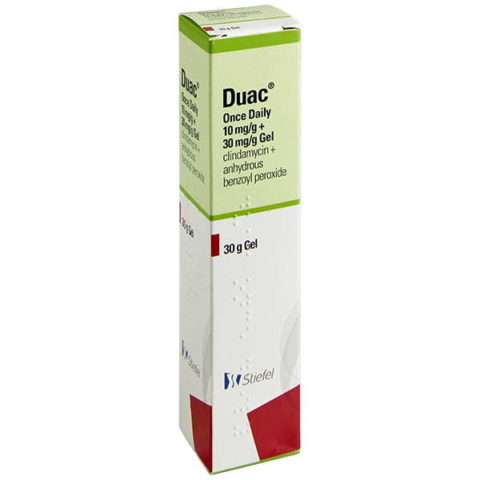Need something else?
We stock over 1099 treatments for 94 conditions

Duac gel is a prescription-only acne treatment that can be very effective, but skin conditions are delicate, so you need to equip yourself with information before you choose a direction for your treatment. That’s why we have created this page to answer all your Duac questions.
Here, we’ll cover what Duac gel does, how it works, how you can use it, and why it isn’t always the right choice. By the end, you should be much better equipped to decide if it may be a good option for your acne.
Duac gel treats mild to moderate acne outbreaks using its two active ingredients: benzoyl peroxide, an antibacterial, and clindamycin, an antibiotic. This dual composition allows it to be more effective at treating acne than treatment with either ingredient alone.
Users of Duac gel typically see improvements in spots and inflammation after around 2-4 weeks of starting daily treatment. If you’re determined to make fast progress with your acne treatment, Duac gel could be an excellent option.

Each of the two active ingredients in Duac gel has distinct effects:
Working together, these effects are additive resulting in more effective acne treatment. The reduced bacterial presence slows the spread of acne, and the exfoliation makes way for healthy skin to arrive.
When Duac gel starts to become effective (likely within a few weeks of daily use), it can have some side effects including additional redness and peeling. This is entirely normal and nothing to be concerned about — if it bothers you greatly, you can discontinue treatment for a few days to let your skin calm down. You can also use an oil-free moisturiser to alleviate dryness and discomfort.
Using Duac gel can also leave your skin sensitive to sunlight and thus vulnerable to additional damage. Keep the affected skin out of the sun (and away from UV lamps), or apply a non-comedogenic sunscreen any time you are out in direct sunlight.
If the side effects of Duac gel go beyond minor irritation and/or don’t go away when you stop using the gel for a few days, consult the medical professional who prescribed it (or your GP, if that’s easier, assuming they didn’t prescribe it).
Once you start applying it, you can expect to see significant results within 2-4 weeks, and better results the longer you use it (treatment can last up to 12 weeks for a completed course). After a 12-week course of Duac gel, it is recommended you have a 2-week break to review your acne before restarting treatment, if necessary. You can read patients’ first-hand experiences with the treatment by reading through some of our Duac gel customer reviews.
That also means that you can tell quickly if it isn’t going to be effective in your case. No skin treatment works for everyone, and there may be some reason why Duac gel doesn’t work for you — if you’ve seen no improvement at all after 8 weeks of daily treatment, consider alternatives.
Duac gel is a topical gel, which means it’s applied directly to the skin. Once it’s been prescribed to you, you should follow the provided course of treatment, which will recommend that you apply the gel once each day (in the evening if possible).
Wash, rinse and dry the acne-affected area, being very careful not to further damage the skin or irritate it with any cleansing substances (dry by patting, no scraping). Stick to using warm water — soap, in particular, will further dry the skin. When the area is dry and ready, place the recommended amount of the gel on your fingertips and use them to rub it in until it’s absorbed.
Beyond that, follow best practices about using Duac gel. Avoid using it with other acne treatments, take good care of your skin, and don’t miss any treatments if possible.
Most acne sufferers can use Duac gel effectively — it is ideal for anyone treating moderate acne where there is redness and inflammation present. That said, it isn’t suitable for everyone in every situation, for example, severe acne may require a stronger treatment like Tetralysal.
For instance, if you’re an acne sufferer already using acne treatments, there’s a good chance that Duac gel won’t be suitable for use alongside it. It’s intended as a solitary treatment - it shouldn't be used alongside other topical or oral antibiotic treatments unless a dermatologist has specifically advised you to do so. Pick just one treatment and stick to it for the duration.
Additionally, as noted earlier, no skin treatment is effective for every user. Many skin conditions still aren’t understood in detail, and so many things can change and go wrong with skin that you can never know exactly how someone will react to a given treatment (check out our main article for Duac gel side effects). You’ll need to get advice from a medical professional, then try Duac gel to see how you respond.
Let’s recap the most important points we’ve looked at in this article:
We stock over 1099 treatments for 94 conditions